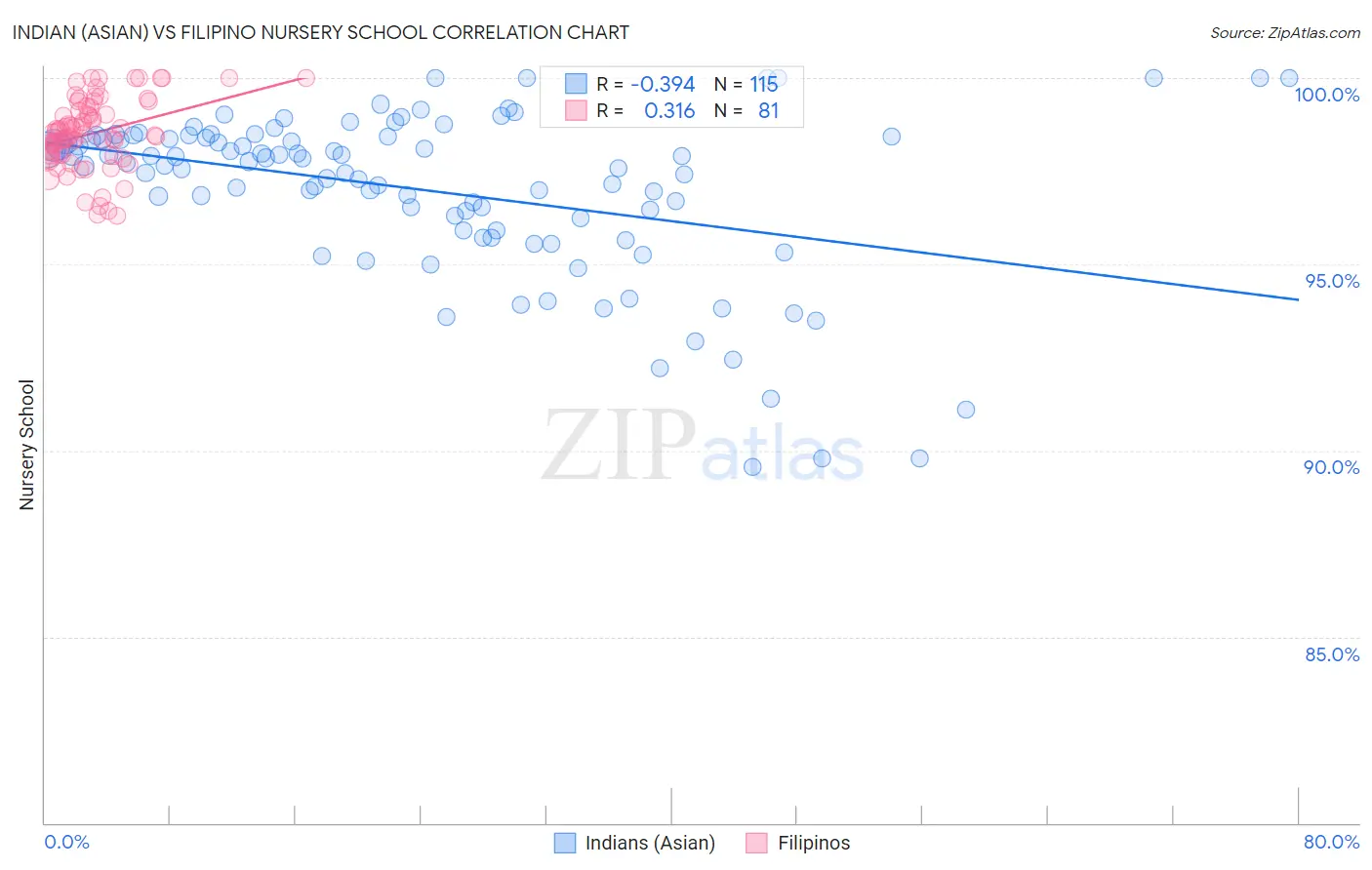Indian (Asian) vs Filipino Nursery School
COMPARE
Indian (Asian)
Filipino
Nursery School
Nursery School Comparison
Indians (Asian)
Filipinos
97.6%
NURSERY SCHOOL
0.9/ 100
METRIC RATING
248th/ 347
METRIC RANK
98.1%
NURSERY SCHOOL
78.5/ 100
METRIC RATING
146th/ 347
METRIC RANK
Indian (Asian) vs Filipino Nursery School Correlation Chart
The statistical analysis conducted on geographies consisting of 495,196,037 people shows a mild negative correlation between the proportion of Indians (Asian) and percentage of population with at least nursery school education in the United States with a correlation coefficient (R) of -0.394 and weighted average of 97.6%. Similarly, the statistical analysis conducted on geographies consisting of 254,351,427 people shows a mild positive correlation between the proportion of Filipinos and percentage of population with at least nursery school education in the United States with a correlation coefficient (R) of 0.316 and weighted average of 98.1%, a difference of 0.45%.

Nursery School Correlation Summary
| Measurement | Indian (Asian) | Filipino |
| Minimum | 89.6% | 96.3% |
| Maximum | 100.0% | 100.0% |
| Range | 10.4% | 3.7% |
| Mean | 97.0% | 98.5% |
| Median | 97.7% | 98.5% |
| Interquartile 25% (IQ1) | 95.9% | 97.9% |
| Interquartile 75% (IQ3) | 98.4% | 99.2% |
| Interquartile Range (IQR) | 2.5% | 1.2% |
| Standard Deviation (Sample) | 2.2% | 0.93% |
| Standard Deviation (Population) | 2.2% | 0.92% |
Similar Demographics by Nursery School
Demographics Similar to Indians (Asian) by Nursery School
In terms of nursery school, the demographic groups most similar to Indians (Asian) are Peruvian (97.6%, a difference of 0.0%), Immigrants from Middle Africa (97.6%, a difference of 0.0%), Immigrants from Eastern Africa (97.6%, a difference of 0.0%), Immigrants from Senegal (97.6%, a difference of 0.0%), and Liberian (97.7%, a difference of 0.010%).
| Demographics | Rating | Rank | Nursery School |
| Immigrants | Indonesia | 1.1 /100 | #241 | Tragic 97.7% |
| Liberians | 1.1 /100 | #242 | Tragic 97.7% |
| Asians | 1.1 /100 | #243 | Tragic 97.6% |
| South Americans | 1.0 /100 | #244 | Tragic 97.6% |
| Bolivians | 1.0 /100 | #245 | Tragic 97.6% |
| Peruvians | 1.0 /100 | #246 | Tragic 97.6% |
| Immigrants | Middle Africa | 0.9 /100 | #247 | Tragic 97.6% |
| Indians (Asian) | 0.9 /100 | #248 | Tragic 97.6% |
| Immigrants | Eastern Africa | 0.9 /100 | #249 | Tragic 97.6% |
| Immigrants | Senegal | 0.9 /100 | #250 | Tragic 97.6% |
| Ethiopians | 0.8 /100 | #251 | Tragic 97.6% |
| Immigrants | Africa | 0.8 /100 | #252 | Tragic 97.6% |
| Immigrants | Iraq | 0.7 /100 | #253 | Tragic 97.6% |
| Immigrants | Congo | 0.7 /100 | #254 | Tragic 97.6% |
| Immigrants | Asia | 0.7 /100 | #255 | Tragic 97.6% |
Demographics Similar to Filipinos by Nursery School
In terms of nursery school, the demographic groups most similar to Filipinos are Immigrants from Israel (98.1%, a difference of 0.0%), Marshallese (98.1%, a difference of 0.010%), Alsatian (98.1%, a difference of 0.010%), Hmong (98.1%, a difference of 0.010%), and Immigrants from Greece (98.1%, a difference of 0.010%).
| Demographics | Rating | Rank | Nursery School |
| Blackfeet | 87.5 /100 | #139 | Excellent 98.1% |
| Palestinians | 83.7 /100 | #140 | Excellent 98.1% |
| Immigrants | Turkey | 83.0 /100 | #141 | Excellent 98.1% |
| Burmese | 81.7 /100 | #142 | Excellent 98.1% |
| Marshallese | 81.2 /100 | #143 | Excellent 98.1% |
| Alsatians | 80.3 /100 | #144 | Excellent 98.1% |
| Immigrants | Israel | 78.5 /100 | #145 | Good 98.1% |
| Filipinos | 78.5 /100 | #146 | Good 98.1% |
| Hmong | 75.7 /100 | #147 | Good 98.1% |
| Immigrants | Greece | 75.4 /100 | #148 | Good 98.1% |
| Apache | 73.2 /100 | #149 | Good 98.1% |
| Jordanians | 72.9 /100 | #150 | Good 98.1% |
| Soviet Union | 71.6 /100 | #151 | Good 98.0% |
| Dutch West Indians | 70.2 /100 | #152 | Good 98.0% |
| Immigrants | Moldova | 69.6 /100 | #153 | Good 98.0% |